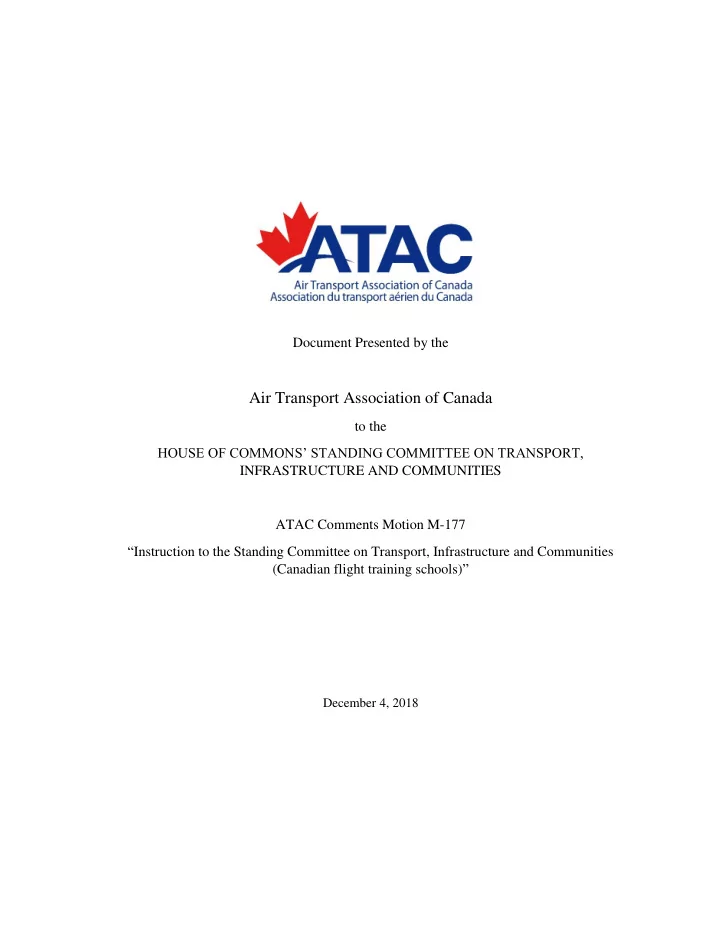

Document Presented by the Air Transport Association of Canada to the HOUSE OF COMMONS’ STANDING COMMITTEE ON TRANSPORT, INFRASTRUCTURE AND COMMUNITIES ATAC Comments Motion M-177 “ Instruction to the Standing Committee on Transport, Infrastructure and Communities (Canadian flight training schools) ” December 4, 2018
Contents Overview ................................................................................................................................................. 4 About ATAC ............................................................................................................................................ 4 Recommendations.................................................................................................................................. 4 Aviation Labour Shortage ....................................................................................................................... 6 Becoming a Pilot ..................................................................................................................................... 7 The ‘Typical’ Pilot Career Path ................................................................................................................ 7
Overview ATAC welcomes this opportunity to present recommendations to the House of Commons’ Standing Committee on Transport, Infrastructure and Communities. The recommendations presented here fall into four broad categories: 1) Support student pilots 2) Support flight schools 3) Support research 4) Support outreach This document also contains background information on topics such becoming a pilot, and the typical pilot career path. About ATAC Founded in 1934, the Air Transport Association of Canada (ATAC) serves as Canada's national trade association for commercial aviation and flight training industries, as well as aviation industry suppliers. Our membership is comprised of about 200 companies engaged in commercial aviation all across the country, including 50 flight training schools that together deliver approximately 80% of all commercial pilot licenses issued in Canada. Representing ATAC on flight training and labour market issues, including the current pilot shortage, is Darren Buss. Darren has an airline transport pilot license and 13 years experience as a professional pilot. He holds the title of Vice President at ATAC, and also sits on the board of directors at the Canadian Council for Aviation and Aerospace (CCAA). Since graduating from the Aviation and Flight Technology program at Seneca College in 2005 he has flown for air operators in Alberta, Manitoba, Saskatchewan, and Ontario, steadily gaining responsibilities as a pilot, training pilot, and manager. Darren holds a Bachelor of Science degree in Mathematical Science (specializing in Computer Science) from McMaster University, where he also studied Materials Engineering, and previously worked as a software developer. Recommendations 1. Implement Government Backed Student Loans for Flight Training [Support Students] Lack of financing is the most often cited reason why people discontinue flight training or choose not to pursue it at all. Making financing available would bring more people into aviation, and also give policy-makers a tool to incentivize people into jobs where they are most needed, such as flight instruction and medevac. A similar incentive program already exists for medical personnel working in remote areas. ATAC is consulting with commercial banks to create a student loan product for pilots. It is clear that banks are not willing to do this unless the loans are backed by government. Fortunately, a relatively small investment by government would result in a nation-wide student loan program for pilots that could then be used to incentivise pilots into jobs where they are desperately needed. ATAC Presented by ATAC P a g e | 4
estimates that less than $5 million per year, over a 10-year program, would be sufficient to do this. This is based on the following: • 600 commercial pilots trained annually (domestic only) • Worst case, all those pilots borrow the full cost of training ($75,000) • 600 pilots/year x $75,000/pilot = $45 million/year borrowed from bank • Modelled loan default rate is 10%, therefore approximately $4.5 million/year goes to default 2. Approve the Proposal to extend SWILP to Pilot Training [Support Students] Student Work Integrated Learning (SWILP) is an excellent skill development program that has helped thousands of students acquire work-related skills. A proposal has been made to extend the applicability of this program to include pilots wishing to become flight instructors or floatplane pilots. This would increase the number of available flight instructors and therefore Canada’s capacity to train more pilots. This proposal has received wide praise from both industry and government, but it has not yet been implemented. 3. Help Flight Schools Invest in New Technology and Infrastructure [Support Flight Schools] The typical Canadian flight school operates aircraft that are older than the pilots who fly them. Newer aircraft are often quieter and more fuel-efficient than older aircraft. They are also more similar to the modern transport aircraft that student pilots will be expected to operate when they join the workforce, which makes them more effective trainers. Simulators are another game- changing technology that is in short supply at most flight schools due to the fact their cost is similar to a new aircraft. New single-engine training aircraft typically cost around $400,000 USD. Multi-engine trainers typically start around $700,000 USD. Certified flight training devices (FTDs), commonly called simulators, start at about $300,000 USD for a single-engine aircraft and go up to several million for larger aircraft. Ideally, flight schools operate 7 single-engine aircraft for every multi-engine aircraft, and as many simulators as they can afford and have the space for. These are huge capital expenses for small businesses that operate on very tight margins. A government program of matching spending on eligible purchases including aircraft, simulators, and facilities expansion (for simulators) would almost immediately increase capacity to train new pilots by enabling flight schools to make these critical investments. Giving preference to aircraft manufactured in Canada would also stimulate aerospace manufacturing in Canada. For example, the government program could offer $1 for every $1 spent by a flight school on aircraft and simulators built outside of Canada, and $1.20 for every $1 spent on products manufactured in Canada. As a rule of thumb, every aircraft added to a flight school’s fleet allows that school to train an additional 7 pilots per year. 4. Establish Approved Training Organizations (ATO) [Support Students & Flight Schools] The Canadian Aviation Regulations (CARs) are the regulatory foundation for all aviation activities in Canada. They have remained largely unchanged since they were introduced in 1996. Since then, many things have changed, including advancements in simulator technology and a shift towards evidence and competency-based training techniques. The wording of the CARs, rooted in the Presented by ATAC P a g e | 5
Recommend
More recommend